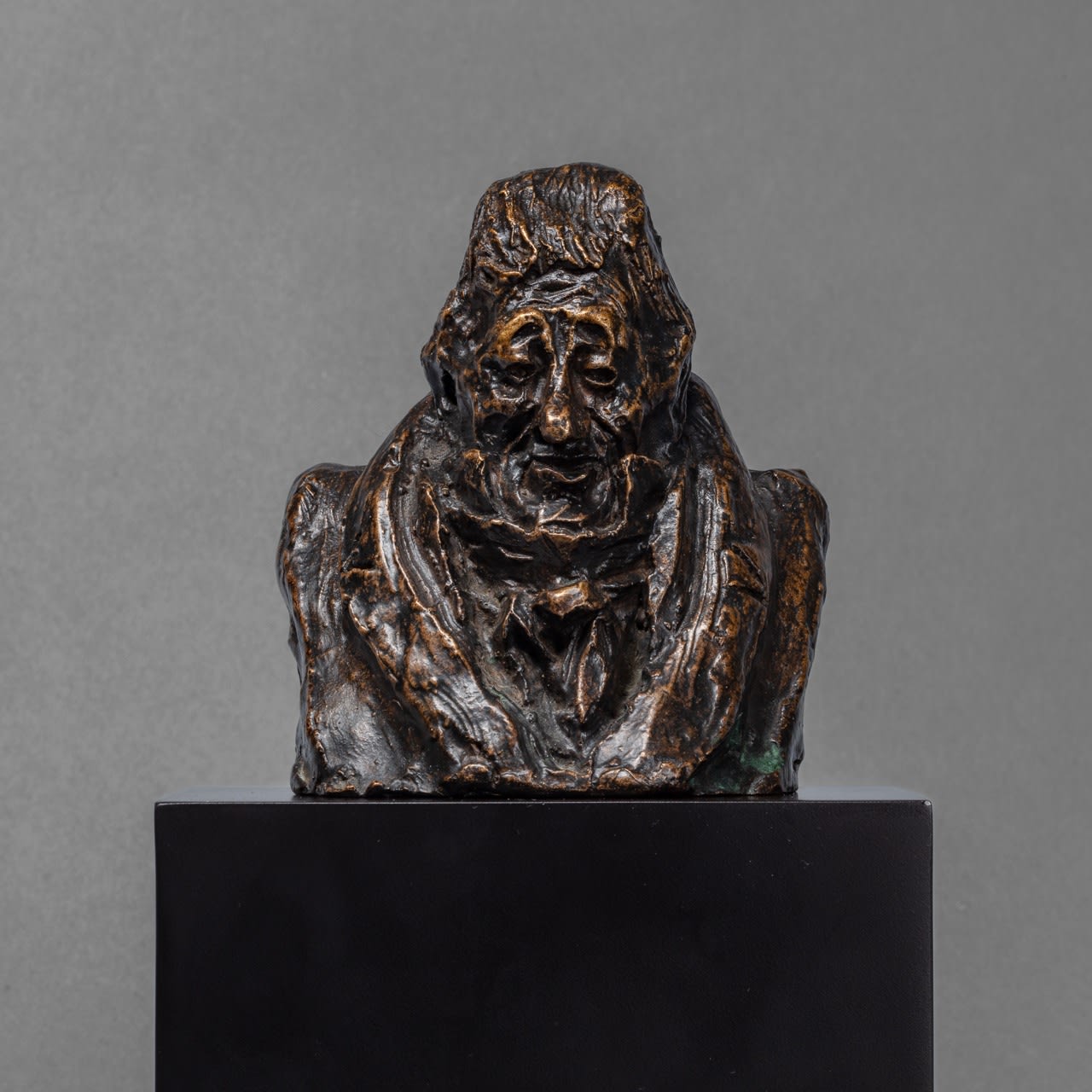Honoré-Victorin Daumier
13 x 11.4 x 8.9 cm
Daumier Register no. 9629
Although never formally trained as a sculptor, Honoré-Victorin Daumier's (1808-1879) bronze busts demonstrate not only his wit and command of caricature beyond his emotive lithographs but also a keen eye for portraiture. Daumier's artistic accomplishments were not restricted to sculpture and lithographs, with his skills extending to sketching, as well as painting in oils and watercolours. Yet his most recognised contributions to modern art remain his caricatures - especially those to which this bust of Pierre-Paul-Royer-Collard (1763-1845) is connected.
From the 1820s, Daumier enjoyed decades-long patronage from the head of the publishing house, Le Maison Aubert, whose journals La Caricature (1830-1848) and Le Charivari (1832-1835) specialised in political and social commentary. Led by Charles Philipon and his brother-in-law, Gabriel Aubert, these journals supplied Daumier with an avenue through which he pilloried the social, political, and cultural elite of Paris in his often controversial lithographs. This working relationship diversified when, in 1832, Philipon commissioned Daumier to produce a series of caricature busts - of which thirty six of the original forty remain and are on display in the Musée d'Orsay's permanent collection. Whilst initially made of clay and worked on concurrently with his lithographs in the same series, these sculptures were later re-cast in bronze following their sale to the dealer-publisher Maurice Le Garrec in the early twentieth century. Through his 'gallery' of what were called The Célébrités of the Juste Milieu, Daumier lampooned both major politicians and minor figures of influence who were at the forefront of the July Monarchy of 1830, which resulted in a liberal constitutional monarchy under the reign of Louis-Philippe I the 'Citizen King'. This regime was viewed negatively, however, in that whilst it rested on a broadened social base the wealthy bourgeoisie dominated its core. Thus, for Daumier and his patron, Philipon, both of whom had been imprisoned under this new administration for slander and non-compliance of press laws respectively, the Celebrities series was an opportunity to challenge the status quo from a Republican and anti-bourgeoisie standpoint.
In these busts Daumier drew on phrenological theory and physiognomy to capture his subjects' likeness in ways that emphasised the depths of their expressions, thus also calling attention to the points of ridicule and satire. Such pseudoscientific theories were commonplace at this time and employed by the social and political elite to distinguish themselves from those they deemed subordinate - whether this be based on socioeconomic, gender, or racial grounds. These ideas were satirised acorss Daumier's busts and lithographs. An example of these techniques can be found in edtion no. 71, plate 143 of La Caricature and is titled 'Masques de 1831' (published 1832). This lithograph is recorded in the Daumier Register no: 42 and depicts fifteen expressive individual faces,
This bust of Pierre-Paul Royer-Collard (1763–1845), French editor, philosopher, statesman, and Member of the Academy was cast in 1929 in bronze with brown patina at the Barbedienne Foundry, it is numbered on the inside 21/25 and stamped on the back with Maurice Le Garrec’s seal. Daumier, the ‘Michelangelo of caricature’ modelled his bronzes from his satirical illustrations and terracotta busts of the French aristocracy and bourgeoisie: through his grotesque caricatural portraits, he derided the character of the archetypal professionals, such as doctors, professors, lawyers, and judges, to expose the flamboyance lifestyle of the rich and juxtapose it with the hardship of the masses. Daumier also sculpted busts of aristocrats, and members of parliament, such as this caricature of Royer-Collard, leader of the Doctrinaires group.
Daumier even ridiculed King Louis-Philippe I, for which he was sentenced to jail for six months. His sculptures are a testament to the ambiguous French restoration, and the failure of Louis-Philippe and his institutions to care for the new industrial classes.
Bronze versions of Pierre-Paul Royer-Collard are held in the following collections: The National Gallery of Art, Washington DC; The Art Institute of Chicago; The Hirshhorn Museum and Sculpture Garden, Washington D.C; Musée des Beaux-Arts Lyon; Museo Soumaya, Mexico City; Musée des Beaux-Arts Marseille; Baltimore Museum of Art. The original clay is held at the Musée d'Orsay, Paris.
Provenance
Private Collection
Bowman Sculpture, London
Private collection, UK
Exhibitions
Museum of Modern Art, New York, Daumier - Corot, 1930Literature
Henri Loyrette et al, Daumier, 1808-1879 (Paris: Paris Réunion des Musées Nationaux, 1999), another cast.Sagot-Le Garrec Gallery, Daumier Sculptor-The busts of the Parliamentarians (Paris, 1979), the plasters and other casts illustrated.
Jeanne L. Wasserman, Daumier Sculpture: A Critical and Comparative Study, exh. cat. (Cambridge, MA: Fogg Art Museum, 1969).
Join our mailing list
* denotes required fields
We will process the personal data you have supplied to communicate with you in accordance with our Privacy Policy. You can unsubscribe or change your preferences at any time by clicking the link in our emails.

